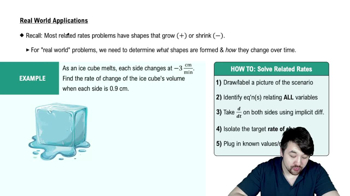Table of contents
- 0. Functions7h 52m
- Introduction to Functions16m
- Piecewise Functions10m
- Properties of Functions9m
- Common Functions1h 8m
- Transformations5m
- Combining Functions27m
- Exponent rules32m
- Exponential Functions28m
- Logarithmic Functions24m
- Properties of Logarithms34m
- Exponential & Logarithmic Equations35m
- Introduction to Trigonometric Functions38m
- Graphs of Trigonometric Functions44m
- Trigonometric Identities47m
- Inverse Trigonometric Functions48m
- 1. Limits and Continuity2h 2m
- 2. Intro to Derivatives1h 33m
- 3. Techniques of Differentiation3h 18m
- 4. Applications of Derivatives2h 38m
- 5. Graphical Applications of Derivatives6h 2m
- 6. Derivatives of Inverse, Exponential, & Logarithmic Functions2h 37m
- 7. Antiderivatives & Indefinite Integrals1h 26m
- 8. Definite Integrals4h 44m
- 9. Graphical Applications of Integrals2h 27m
- 10. Physics Applications of Integrals 2h 22m
4. Applications of Derivatives
Related Rates
Problem 3.11.16
Textbook Question
The edges of a cube increase at a rate of 2 cm/s. How fast is the volume changing when the length of each edge is 50 cm?
 Verified step by step guidance
Verified step by step guidance1
First, identify the formula for the volume of a cube, which is V = a^3, where 'a' is the length of an edge.
Next, differentiate the volume formula with respect to time 't' to find the rate of change of the volume. This gives us dV/dt = 3a^2 * (da/dt).
Substitute the given rate of change of the edge length, da/dt = 2 cm/s, into the differentiated formula.
Substitute the given edge length, a = 50 cm, into the formula. This will allow you to calculate the rate at which the volume is changing at that specific edge length.
Finally, compute the expression to find the rate of change of the volume, dV/dt, using the substituted values.
 Verified video answer for a similar problem:
Verified video answer for a similar problem:This video solution was recommended by our tutors as helpful for the problem above
Video duration:
2mPlay a video:
Was this helpful?
Key Concepts
Here are the essential concepts you must grasp in order to answer the question correctly.
Related Rates
Related rates involve finding the rate at which one quantity changes in relation to another. In this problem, we need to determine how the volume of the cube changes as the length of its edges increases. This requires applying the chain rule of differentiation to relate the rates of change of the edge length and the volume.
Recommended video:

Intro To Related Rates
Volume of a Cube
The volume of a cube is calculated using the formula V = s^3, where s is the length of an edge. Understanding this formula is crucial because it allows us to express the volume in terms of the edge length, enabling us to differentiate it with respect to time to find the rate of change of volume.
Recommended video:

Real World Application
Differentiation
Differentiation is a fundamental concept in calculus that involves finding the derivative of a function. In this context, we differentiate the volume function with respect to time to find how fast the volume is changing as the edge length changes. This process involves applying the power rule and the chain rule to relate the rates of change.
Recommended video:

Finding Differentials
Related Videos
Related Practice




